air condition AUDI A5 COUPE 2011 Owner's Guide
[x] Cancel search | Manufacturer: AUDI, Model Year: 2011, Model line: A5 COUPE, Model: AUDI A5 COUPE 2011Pages: 362, PDF Size: 84.88 MB
Page 298 of 362
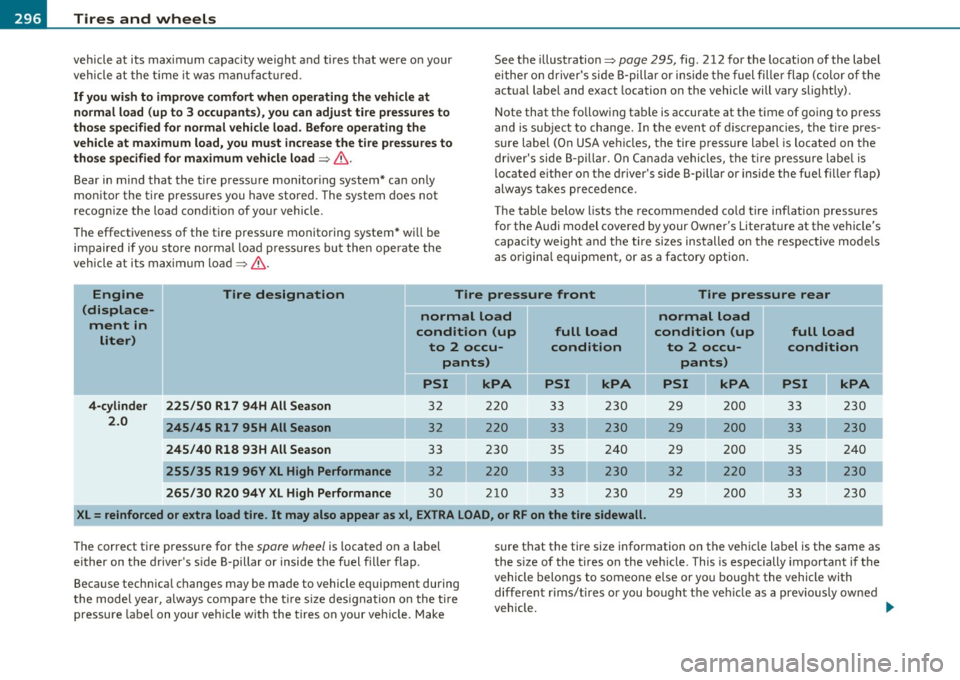
-~_T_ ir_e_ s_ a_ n_ d_ w_ h_e_ e_ ls _______________________________________________ _
vehicle at its maximum capacity weight and tires that were on your
vehicle at the tim e it was manufactured.
If you wish to improve comfort when operating the vehicle at
normal load (up to 3 occupants) , you can adjust tire pressures to
those specified for normal vehicle load. Before operating the
vehicle at maximum load, you must increase the tire pressures to
those specified for maximum vehicle load
=> &.
Bear in mind that the tire pressure monitoring system* ca n only
monitor the tire pressures you have stored. The system does not
recogn ize the load condit ion of your vehicle.
The effectiveness of the tire pressure monitoring system* wi ll be
impaired if you store normal load pressures but then operate the
vehicle at its maximum load
=> &.
See the illustration => page 295, fig. 212 for the locat ion of the label
either on driver's side B-pillar or inside the fuel filler flap (color of the
actual label and exact location on the vehicle will vary slightly).
Note that the following tab le is accurate at the time of going to press
and is subject to change. In the event of discrepancies, the tire pres
sure label (On USA vehicles, the tire pressure label is located on the
dr iver's side B-pillar. On Canada vehicles, the tire pressure label is
located e ither on the driver's s ide B-pillar or inside the fuel filler flap)
always takes precedence.
The table below lists the recommended cold tire inflation pressures
for the Audi model covered by your Owner's Literature at the vehicle's
capacity weight and the tire sizes installed on the respective models
as origina l equipment, or as a factory option.
Engine
(displace ment in liter) Tire designation
Tire pressure front Tire pressure rear
normal load normal load
condition (up full load condition
(up
full load
to 2 occu- condition to 2 occu- condition pants) pants)
PSI Jl kPA PSI kPA PSI kPA PSI II kPA
4-cylinder 225/50 Rl 7 94H All Season 32 220 33 230 29 200 33 230
2.0
245/45 Rl 7 95H All Season 32 220 33 230 29
200 33 230
245/40 R18
93H All Season 33 230 35 240 29 200 35 240
255/35 R19 96V XL High Performance 32 220 33 230 32 220 33 230
265/30 R20 94Y XL High Performance 30 210
33 230 29 200
33 230
XL=
reinforced or extra load tire. It may also appear as xi, EXTRA LOAD, or RF on the tire sidewall.
The correct tire pressure for the spare wheel is located on a label
either on the driver's s ide B-pillar or inside the fuel filler flap.
Beca use technica l changes may be made to vehicle equipment during
the model year, always compare the tir e s ize designation on the tir e
pressure label on your vehicle with the tires on your vehicle. Make sure that the tire size information on the vehicle label is the same as
the
size of the tires on the vehicle. This is especially important if the
vehicle belongs to someone e lse or you bought the vehicle with
different rims/tires or you bought the veh icle as a previous ly ow ned
vehicle. _.,,
Page 308 of 362
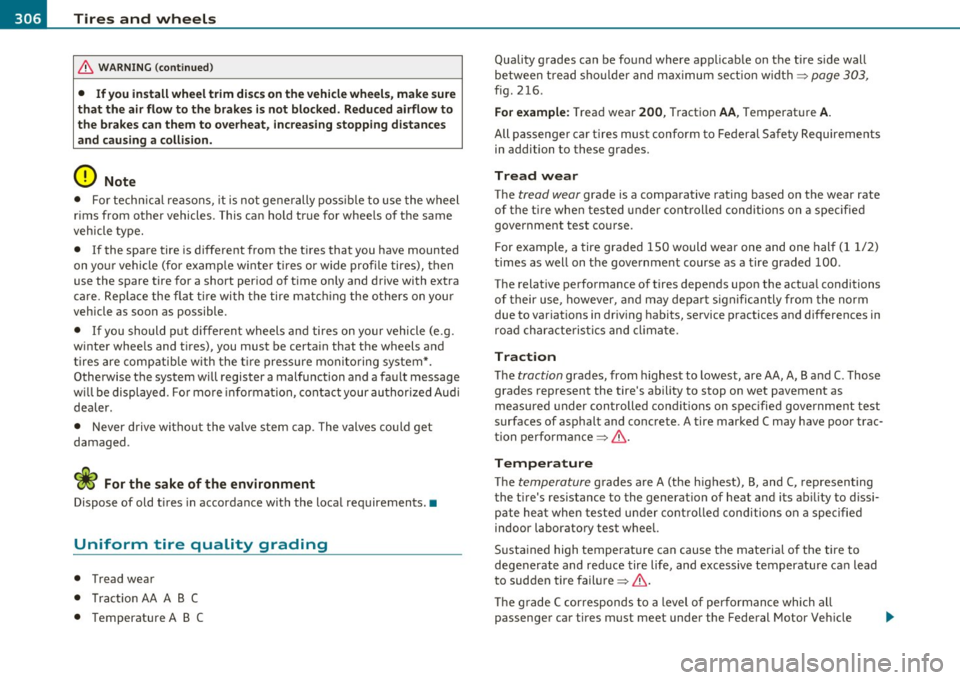
-~_T_ i_ re _ s_ a_n _ d_ w_ h _e_ e_ ls _________________________________________________ _
& WARNING (conti nu ed )
• If you install wheel trim disc s on the vehicle wheels , make sure
that the air flow to the brakes is not blocked . Reduced airflow to
the brakes can them to ove rhe at, increasing stopping distances
and cau sing a collision .
0 Note
• For tech nical reasons, it is not ge ne rally poss ib le to use the wheel
r ims from other vehicles. This can hold true for whee ls of the same
veh icle type.
• If the spare tire is different from the t ires that you have mounted
on yo ur veh icle (for examp le w inte r tir es or wide profile tires), then
use the spare tire for a short per iod of t ime on ly and drive with extra
c are . Replace the fla t ti re wi th t he tire matc hing the o thers on you r
vehicle as soon as possible .
• If you should put differen t wheel s and tires o n yo ur vehicle (e.g.
w inter whee ls and t ires), you must be certa in that the wheels and
ti res are comp atib le with the t ire pressure mon ito ring system*.
Otherwise the system will register a malfu nction and a fau lt message
w ill be displ ayed. Fo r more informa tion, conta ct your au thori zed Au di
dealer.
• N ever drive wi tho ut the valve s tem cap. The valves co uld get
damaged .
Uniform tire quality grading
• Tread wear
• Tr act io n AA A B C
• T emperature A B C Quality grades can be fo
und where app licab le on the tire s ide wall
betwee n tre ad sho uld er and m aximum se ct io n width =>
page 3 03,
fig .216.
Fo r example : Tread wea r 200, Tract ion AA , Temperat ure A.
All passenge r car ti res mus t confo rm to Fe d er al Safety Requireme nts
in addition to these grades.
Tread wear
T he tread wear grade is a comparative rating based on the wear rate
of the t ire whe n tes ted under cont rolle d conditions on a specifie d
government test co urse.
F or example, a tire graded 150 would wear one a nd one hal f (1 1/2)
t imes as well on t he government course as a tire graded 100 .
The relat ive performance o f tires depen ds upon the act ua l conditions
of their use, however, and may de pa rt sign ifican tly from the no rm
due to variat ions in dr iv ing hab its, se rvice practices and differences in
ro ad characte ris tic s and climat e.
Traction
Th e traction grades, from high est to lowest, ar e AA, A, Band C. Those
grades represent the tire's ability to stop on wet pavement as
me asu red under con trolled conditions on spe cifie d gove rnme nt te st
surfaces of asphalt and conc rete . A tire marked C may have poo r trac
ti on perfo rm an ce =>& .
Temperature
The temperature grades a re A (the h ig hest), B, and C, represen ting
the t ire's resistance to the generation of heat and its ab ility to d issi
p ate he at when teste d und er co ntro lled condition s on a s pecifie d
indoor laboratory test wheel.
Susta ined high tempera ture can cause the materi al of the tire to
degenerate and red uce tire life, and excessive te mperature ca n lead
to sudden tire failure=> & .
Th e g ra d e C c orresponds to a level of pe rforman ce which all
passenge r ca r tires must meet under the Federal Motor Veh icle
Page 309 of 362
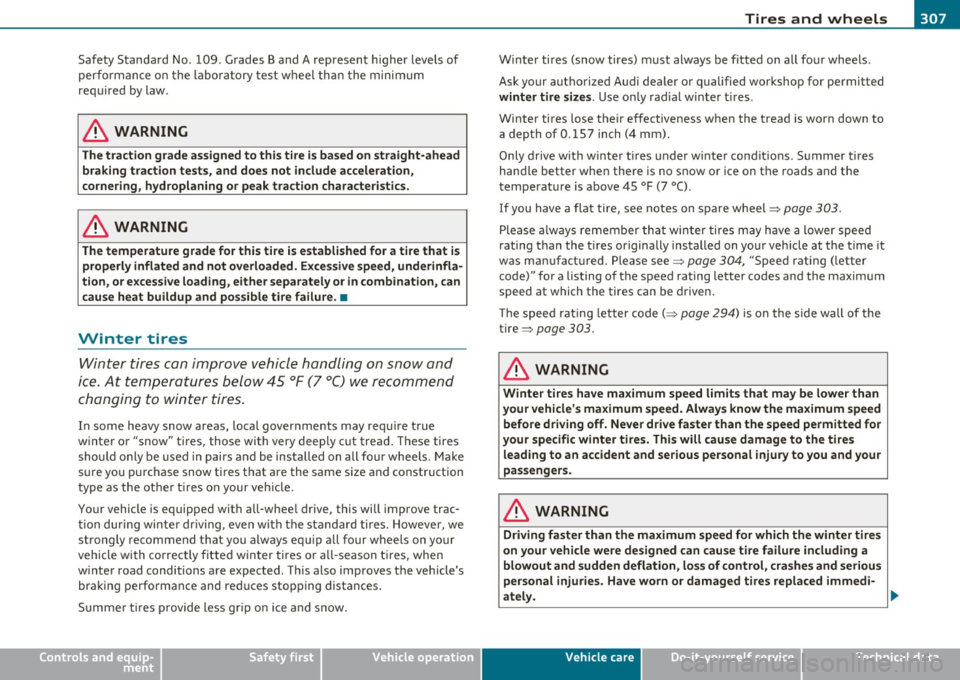
________________________________________________ T....:.i.:....r -=e -=s -=.: a..:.n .:.... d::..:__ w:..:....: h..:. e -=-= e:...:l-=s --"'
Sa fety Standa rd No. 109 . G rades Ba nd A rep resent higher levels of
p erf or ma nce on t he laborato ry tes t w hee l than t he mini mum
r e q uir ed by law .
& WARNING
The traction grade assigned to this tire is based on straight-ahead
braking traction tests, and does not include acceleration,
cornering, hydroplaning or peak traction characteristics.
& WARNING
The temperature grade for this tire is established for a tire that is
properly inflated and not overloaded. Excessive speed, underinfla
tion, or excessive loading, either separately or in combination, can
cause heat buildup and possible tire failure. •
Winter tires
Winter tir es co n imp rove ve hi cle ha ndlin g on sno w an d
ice. At temp eratur es be low 45 °F (7 °C) w e rec ommen d
ch angin g to wi nte r tires .
In some heavy snow areas, loca l gover nme nts may requ ire t rue
w inter o r "snow" tires, those with very deep ly cut trea d. These tires
sho uld only be used in pairs and be installed on all four wheels . Make
s ur e you pu rc h ase snow ti res t hat a re the same size and const ruction
type as the ot he r tir es o n your veh icle .
Your vehicle is equipped wi th all-whee l dr ive, this wi ll improve trac
ti on dur ing w inter dr iv in g, even w it h th e stand ard tire s. Howeve r, we
strong ly recommend t hat you a lways equ ip all four wheels on yo ur
vehicle wi th co rrec tly fitte d win ter tires o r all- season tires, when
w inter road conditions are expected . T hi s also improves the veh icle 's
bra king perfo rma nce and re duces stop ping distances .
S um mer tir es p rovide less gr ip on ice and s now .
Safety first
Wi nter tires (snow tires) m ust always be fitted on all fo ur whee ls .
Ask yo ur aut horized Audi dealer o r q ualified wor kshop for permitted
winter tire sizes . Use only rad ia l w inte r tir es .
Winter tires lose t heir effectiveness whe n the trea d is worn down to
a dep th of 0 .157 inch ( 4 m m).
Only dr ive w it h w inter t ires u nder w inte r cond it io ns. S u mme r tir es
hand le better w hen the re is no snow or ice on the roads an d the
t empe ra tu re is a bove 45
°F (7 °() .
If you have a flat ti re, se e notes on s pare w hee l=> page 303.
P lea se al way s rem em ber th at win ter tire s ma y have a lower speed
rating t han the t ires or iginally installed on yo ur veh icle at t he t ime it
was ma nufact ured. Please see=>
page 304, "S pee d rat ing ( letter
code)" for a lis ting of the s peed rating letter codes a nd the maxim um
speed at which the tires can be dr iven .
Th e spee d ratin g le tt er code( =>
page 294 ) is on the s ide w all o f the
t ire=>
page 303 .
& WARNING
Winter tires have maximum speed limits that may be lower than
your vehicle's maximum speed. Always know the maximum speed
before driving off. Never drive faster than the speed permitted for
your specific winter tires. This will cause damage to the tires leading to an accident and serious personal injury to you and your
passenger s.
& WARNING
Driving faster than the maximum speed for which the winter tires
on your vehicle we re designed can cause tire failure including a
blowout and sudden deflation, loss of control, crashes and serious
personal injuries. Have worn or damaged tires replaced immedi-
ately. .,,_
Vehicle care Technical data
Page 312 of 362
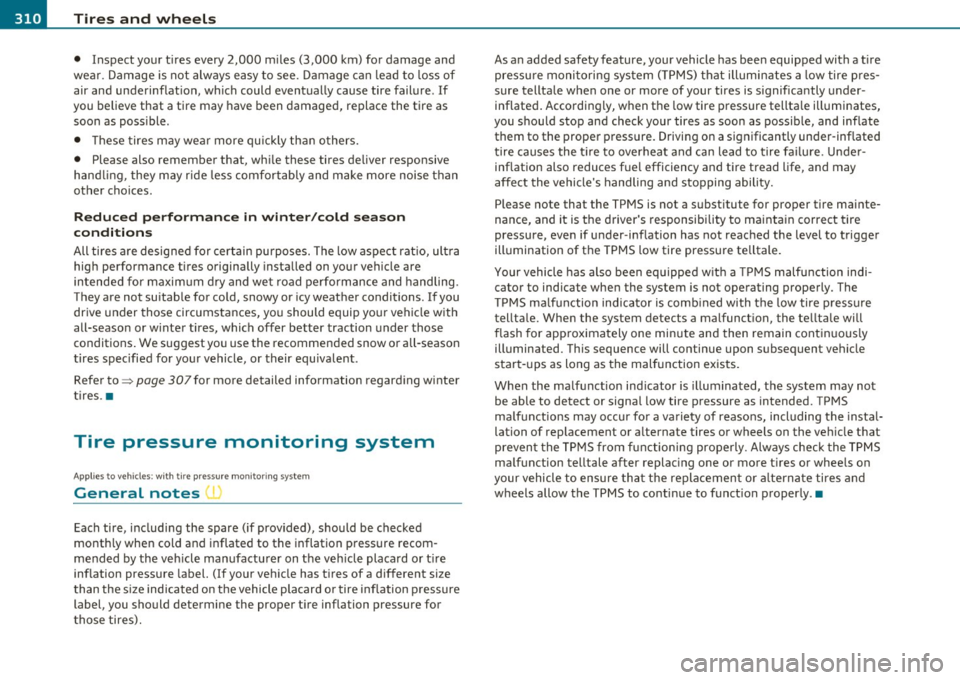
-~_T_ i_ re _ s_ a_n _ d_ w_ h _e_ e_ ls _________________________________________________ _
• Inspect your tires every 2,000 miles (3,000 km) for damage and
wear . Damage is not always easy to see. Damage can lead to loss of
air and underinflat ion, which could eventually cause tire failure. If
you believe that a tire may have been damaged, replace the tire as
soon as poss ible .
• Th ese tires may wear more quickly than others.
• Please also remember that, whi le these tires deliver responsive
hand ling, they may ride less comfortably and make more noise than
other choices.
Reduced performance in winter/cold season
conditions
All tires are designed for certain purposes. The low aspect rat io, ultra
high performance tires originally installed on your vehicle are
intended for maxim um dry and wet road performance and handling.
They are not suitable for cold, snowy or icy weather conditions . If you
drive under those circumstances, you should equip your vehicle with
all-season or winter tires, which offer better traction under those
conditions. We suggest you use the recommended snow or all-season
tires specified for your vehicle, or their equivalent.
Refer to=:,
page 307for more detailed information regarding winter
tires .•
Tire pressure monitoring system
Ap plies to ve hicl es : w it h t ire pressur e m onito rin g syst em
General notes
Each tire , including the spare (if provided), shou ld be checked
month ly when cold and inflated to the inflation pressure recom
mended by the veh icle manufacturer on the vehicle placard or t ire
inf lation pressure label. (If your vehicle has t ires of a diffe rent size
than the siz e indicated on the vehicle placard or tire inflation pressure
label, you should determine the proper tire inflation pressure for
those tires). As
an added safety feature, your vehicle has been equipped with a tire
pressure monitoring system (TPMS) that illumi nates a lo w tire pres
sure telltale when one or more of your tires is significantly under
inflated. Accordingly, when the low tire pressure telltale illuminates,
you should stop and check your tires as soon as possible, and inflate
them to the proper pressure. Driving on a significantly under-inflated
tire causes the tire to overheat and can lead to tire failure . Under
inf lation also reduces fuel efficiency and tire tread life, and may
affect the vehicle's handling and stopping ability.
Please note tha t the TPMS is not a substitute for proper tire mainte
nance, and it is the driver's responsibility to maintain correct tire
pressure, even if under-inflation has not reached the level to trigger
illumination of the TPMS low tire pressure telltale.
Your vehicle has also been equipped with a TPMS malfunction indi
cator to indicate when the system is not operating properly. The
TPMS malfunction indicator is comb ined with the low tire pressure
telltale. When the system detects a malfunction, the telltale will
flash for approximately one minute and then remain continuously
illuminated. This sequence will continue upon subsequent vehicle
start-ups as long as the malfunction exists.
When the ma lfunction ind icator is illuminated, the system may not
be able to detect or signal low tire pressure as intended. TPMS
malfunctions may occur for a variety of reasons, including the insta l
lation of replacement or alternate tires or wheels on the veh icle that
prevent the TPMS from functioning properly. Always check the TPMS
malfunction telltale after replacing one or more tires or wheels on
your vehicle to ensure that the replacement or alternate tires and
wheels allow the TPMS to cont inue to function properly. •
Page 314 of 362

Ill Tires and wheels
-------------------
& WARNING (continued)
overheat and can lead to tire failure . Under-inflation also is likely
to impair the vehicle's handling and stopping ability.
• The driver is responsible for maintaining the correct tire pres·
sures. You must check the tire pressures regularly.
• Under certain conditions (such as a sporty driving style, winter
conditions or unpaved roads), the pressure monitor indicator may
be delayed.
• Ask your authorized Audi dealer if run-flat tires may be used on
your vehicle. Your vehicle registration becomes invalid if you use
these tires when not permitted. Damage to your vehicle or acci
dents could also result.
[ i J Tips
• The tire pressure monitoring system stops working when there is
an ESP/ABS malfunction.
• Using snow chains may resu lt in a system ma lfunction .
• To ensure a proper TPMS function use AUDI Original Tires which
are marked with "AO" or "RO" on the tire sidewall. =>
page 303.
• The tire pressure monitor ing system on your Audi was calibrated
using tires with the "AO" or "RO" identification. We recommend
using these tires.•
Applies to vehicles: with tir e pressure monitoring system
Reset tire pressure monitoring system
If the tire pressure is adjusted, wheels are rotated or
changed, the TPMS must be reset via radio or MMI*.
-Turn on the ignition.
- Select: the [ CAR] function button
> Tire pressure
monitoring
> Store now.
W Tips
Before resetting the TPMS, the current pressures of all four t ires
must correspond to the specified values . Adjust the tire pressure and
reset the pressure in the tire pressure monitoring system according
to the load you are carrying=>
page 295. •
Page 342 of 362
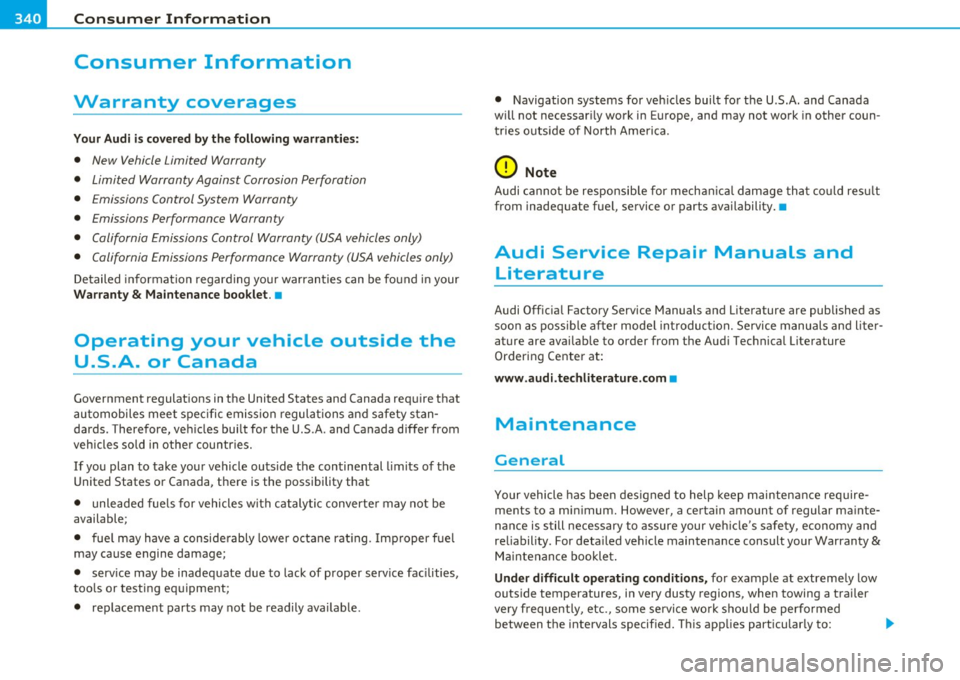
___ C_ o_n_ s _ u_m_ e_ r_ I_ n_ f_o _r_ m_ a_ t_io _ n _____________________________________________ _
Consumer Information
Warranty coverages
Your Audi is cov ered by the following warrantie s:
• New Vehicle Limited Warranty
• Limited Warranty Against Corrosion Perforation
• Emissions Control System Warranty
• Emissions Performance Warrant y
• California Emissions Control Warranty (USA vehicles only)
• California Emissions Performance Warranty (USA vehicles only)
Detailed informa tion regarding your warran ties can be fo und in your
Warranty & Maintenance boo klet .•
Operating your vehicle outside the
U.S.A. or Canada
Government regulat ions in the United States and Canada req uire t hat
au tomobiles meet spe cific emi ss ion regula tions and safe ty s tan
dards . There fore, ve hicles bui lt for the U.S.A . and Canada differ from
vehicles so ld in othe r countries.
If you plan to take your vehicle ou tside the continental lim its of the
United States or Canada, the re is the possibility that
• unle aded fue ls for vehicle s w ith c ataly tic converte r may n ot be
available;
• fue l may have a conside rably lower octa ne rat ing . Imp roper f ue l
may cause engine damage;
• serv ice may be inadequate due to lack of proper serv ice fac ilities,
too ls or testing eq uipment;
• replacement parts may not be read ily avai lab le . • N
avigation syst ems for veh icles built fo r th e U.S.A. and Canada
w ill not necessar ily work in Europe, and may not wo rk in other coun
tries outside of North Ame ric a.
0 Note
Audi canno t be responsib le for mech anical dam age th at could res ult
from inadeq uate fue l, se rvice o r parts ava ilability. •
Audi Service Repair Manuals and
Literature
Audi Off ic ia l Facto ry Service Manuals and Lite rature are published as
so on as p ossible a fter mode l int rodu ct ion. Service manu als and liter
ature are avai lab le to order from t he Aud i Tec hnical Lite rature
O rder ing Cente r at:
www.audi .techliterature .com •
Maintenance
General
Your vehicle has been des igned t o help keep m ainten ance re quire
ments to a min imum. However, a certain amount of regular ma inte
n an ce i s still ne cessary to assure your ve hicle's sa fe ty, ec onomy and
re liability . For deta iled veh icle maintena nce consult your Warranty
&
Maint enance bookle t.
Under difficult operating conditions, for example at extreme ly low
outs ide temperatures, in very dusty regions , when towing a trai le r
very frequent ly, etc., some se rv ic e w ork s hou ld be perfo rmed
between t he intervals specif ied. This app lies part icularly to: .,_